The thick crescent Moon occults oodles of stars in the Beehive open cluster Friday evening for much of the Americas.
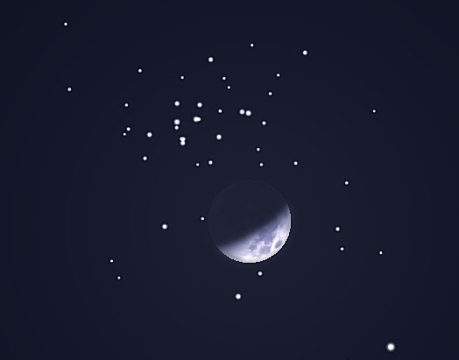
Stellarium
The Moon might just need a beekeeping suit Friday. That evening it crosses the Beehive Cluster in Cancer, occulting many 6th- to 9th-magnitude stars in the space of about 3 hours. The brightest is Epsilon (ε) Cancri at magnitude 6.3, but about a dozen additional stars between magnitude 6 and 7 lie in its path.
The event happens during the early evening hours with the Moon 39% illuminated. Observers in the eastern half of the Americas are favored, with the best U.S. locations east of the Rocky Mountains. Farther west, the Moon will have departed the cluster by the time the sky gets dark enough for a look.
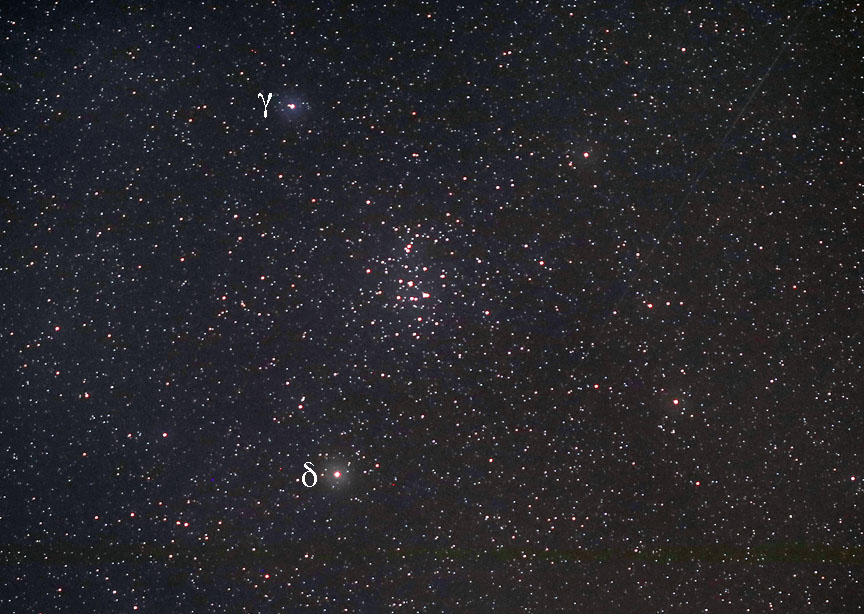
Bob King
Cluster stars will disappear along the dark limb and reemerge anywhere from minutes up to an hour later at the bright limb, depending on how centrally Moon passes over them. Stars occulted at the Moon's polar extremities will disappear for just a minute or two. Depending on your latitude, which affects how centrally the Moon crosses the cluster, you may even see one or more grazing occultations, where a star plays hide-and-seek behind mountain peaks and crater walls as it scrapes along the Moon's northern and southern limbs.

Stellarium
It's fortunate the Moon's phase is just under half. Provided you keep the bright half out of the field of view, you should have no problem seeing the dimmer, Earth-lit limb approach and cover the stars in its path. Even a small telescope will provide a good view.
Where the event is visible, you can begin watching as soon as 30 minutes after sunset. As the Moon slowly hides one star after another, you'll get a sense of its path through the cluster and anticipate which ones are next in line to disappear. The map below provides the names and magnitudes of the cluster's brighter members.
The most curious aspect of occultation-watching, at least for me, is how long a star appears to hover over the lunar limb before finally blinking out. Perhaps the anticipation of its disappearance makes time slow down. But when the moment finally arrives, the star vanishes almost instantaneously. Indeed, it happens so fast I'm always a bit surprised at the suddenness. Slightly longer occultations or a step-wise disappearance, which are uncommon, could indicate that the star is a close binary or a massive supergiant.
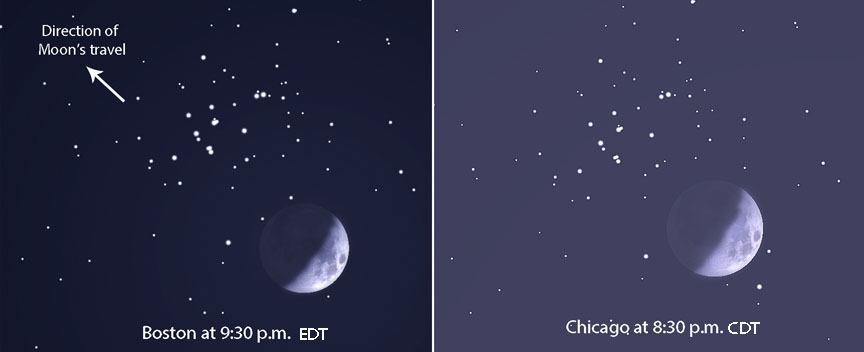
Stellarium
Astrophotographers might enjoy taking a photo of the scene every few minutes to create a time-lapse video showing the Moon's progress across the cluster. Other pleasures of occultation-watching include seeing with your own eyes that the Moon has next to no atmosphere, the reason disappearances are so sudden. If the Moon possessed a substantial atmosphere, we'd see stars slowly fade as the lunar limb approached. Personally, I always get a kick watching the Moon move in real time, and you can only do it during an eclipse or occultation. The Moon's average orbital speed is 3,660 km/hour.
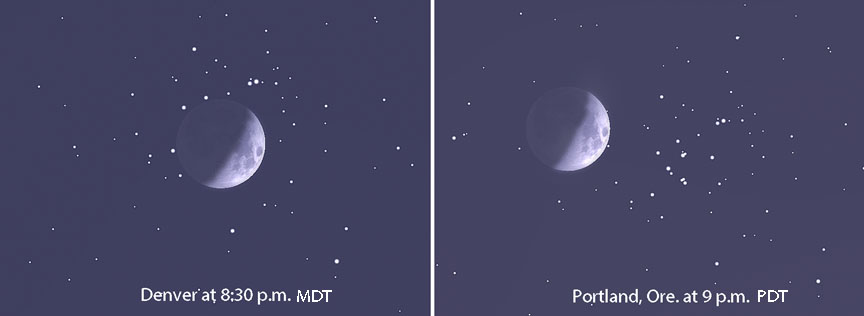
Stellarium
As mentioned earlier, the Moon's particular path through the Beehive depends on your latitude. If you live in the northern U.S. or Canada, the Moon passes south of the cluster's center. From Central America, it crosses centrally, and from South America, north of center.
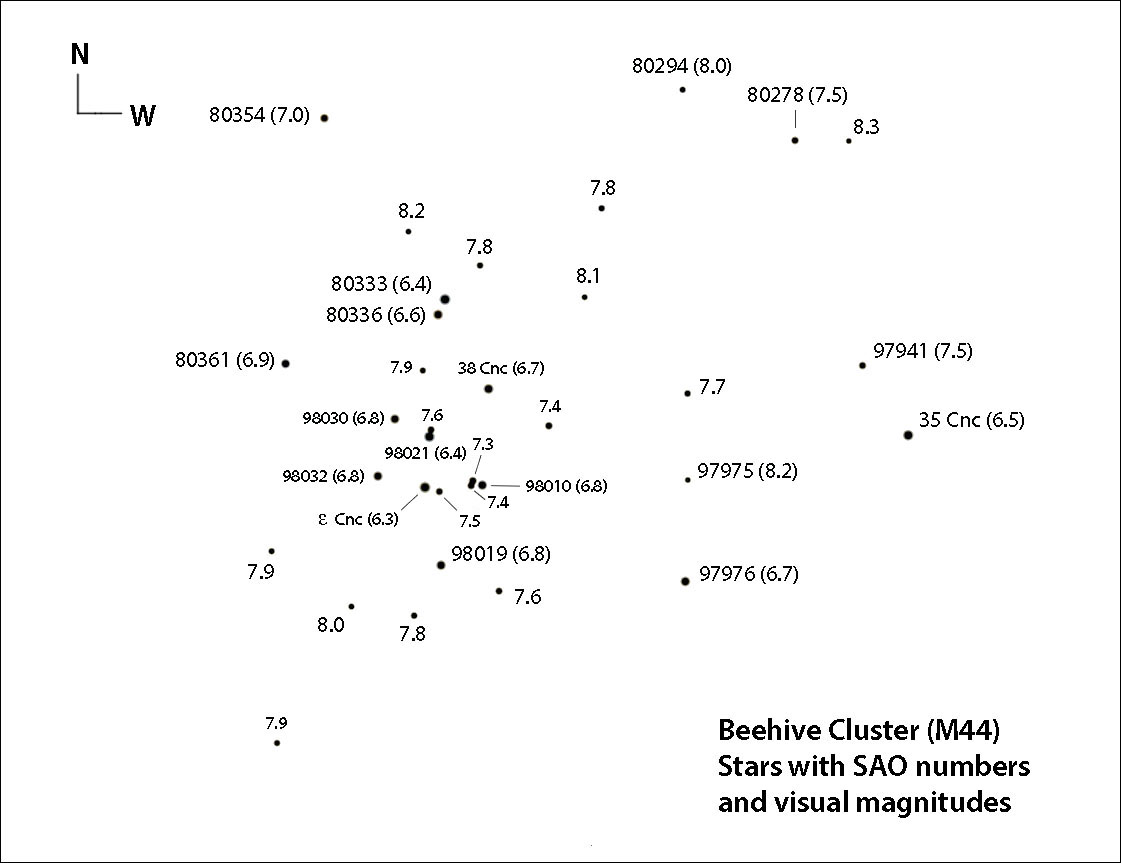
Stellarium with additions by the author
You can see exactly how the Moon travels through the Beehive by firing up a free software program like Stellarium, selecting your location, and running a simulation. Or you can create a customized lunar path by downloading Occult 4 along with these instructions.
Skywatchers in the Eastern Time Zone have the best views with the Moon in a dark sky as it begins its trek across the Beehive. I'm in the Midwest and plan to be out with my scope about a half-hour after sunset (9 p.m. for my location) in bright twilight to catch as many occultations as possible.
This video shows the Beehive occultation on April 13, 2019, which was visible from Europe.
Twilight interferes a bit for the Midwest and more so for the near-western states, but except for the Far West, at least a few occultations will be visible from many locations. In the East, you can start watching around 9:30 p.m. EDT with the Moon nearest the center of the Beehive around 11 p.m. In the Midwest, the Moon crosses centrally around 10 p.m. CDT, and in the Mountain states around 8:30 and 9 p.m. MDT. For more details, visit the International Occultation Timing Association's page.
Now all we need are clear skies. Check your prospects at the Astropheric website, an excellent tool for North American skywatchers.
 4
4









Comments
Anthony Barreiro
May 8, 2019 at 6:42 pm
Astrospheric is a great resource. Thanks for the suggestion!
Here on the west coast, I'll miss Luna's beekeeping activity. I've had that experience of time standing still while waiting for the Moon to occult a star. And then, suddenly, no more star!
By the way, I've been hoping you'll create a chart for Cere's opposition. I should probably figure out how to do that myself. I've got sky safari on my ipad, but I find a printed chart and a red flashlight easier to use.
You must be logged in to post a comment.
Rod
May 10, 2019 at 11:21 pm
Bob King, this looked like a promising occultation of stars tonight by the Moon passing through M44. Notes from my viewing in Maryland. Observed 2100-2200 EDT/0100-0200 UT 11-May-19. First Quarter Moon 12-May-19 at 0112 UT or 2112 EDT 11-May-19. Bob King reports "The thick crescent Moon occults oodles of stars in the Beehive open cluster Friday evening for much of the Americas." Good effort to view the Moon passing through M44 tonight and see some stars occulted by the Moon but weather was a no go. I used a 14-mm eyepiece for 71x, just about 1-degree true field of view and my trusty, 90-mm refractor with Telrad. Altocumulus clouds moving by and cirrus from some showers and t-storms in the area along with distant lightening in the sky. I did see some of the stars of M44 in 2:00 position with part of the Moon and terminator line near 8:00 position in mirror reverse view, north up. Too many clouds passing by to observe any stars occulted tonight by the Moon as it moves through the Beehive star cluster. After 1 hour observing I went in because thick clouds were moving in from W and WNW, rain showers followed shortly after. I could not observe this entire event tonight. The stars of M44 in the eyepiece view promised a good view of stellar occultations tonight by the Moon but weather for me did not cooperate.
You must be logged in to post a comment.
Bob KingPost Author
May 13, 2019 at 2:40 pm
Sorry to hear, Rod. Better luck next.
You must be logged in to post a comment.
Anthony Barreiro
May 14, 2019 at 6:09 pm
Thanks for suggesting astrospheric. It's a great resource with lots of information and a very well designed interface.
Here in SF I missed the lunar occultations of the beehive cluster stars. Watching previous occultations, I've had that experience of time standing still while waiting for the Moon to pass in front of a star, and then, suddenly, no star. A lot of the drama comes from the fact that if you look away from the eyepiece for even a moment, that will be the moment of the occultation.
Saturday night my astronomy club had our monthly public night on Mount Tamalpais. Our observing location at 1872 feet elevation was just above the top of the marine layer of clouds, so we had a beautiful clear sky, quite a treat as the weather in the city has been overcast. After the visitors went home club members had the sky to ourselves. A few diehards who stayed after midnight were treated to an eclipse of Europa by Jupiter's shadow. And I caught my first sight of Ceres during her current apparition in Ophiuchus just east of the head of Scorpius. Using the chart in the May Sky and Telescope she was an easy find in 10x42 binoculars and a 60 mm refractor.
You must be logged in to post a comment.
You must be logged in to post a comment.